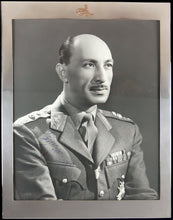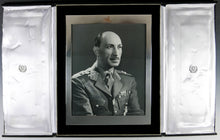Royal Presentation Portrait of Mohammad Zahir Shah, Last King of Afghanistan (1933-1973), Circa 1965
Adding product to your cart
Frame overall: 34cm (13.5in) x 26.5cm (10.5in)
An autographed black and white head and shoulders portrait photograph of Mohammad Zahir Shah. Signed in the king’s hand upper left and presented in a bespoke mahogany backed silver frame applied with gold tughra as displayed on the reverse of the royal flag of Nadeer Shah. The whole contained in a velvet lined fitted case with silks emblazoned with the royal arms: a mosque with a minbar and a mihrab, between two national flags in the base, the date 1348 H (the solar Islamic calendar equivalent of 1929 AD - the year Zahir Shah's dynasty came to power) set within a garland of ears of wheat tied with a ribbon, over the motto ‘Afghanistan’ in arabic script.
Read more
Mohammad Zahir Shah (1914-2007) was born in Cabul and educated at the Pasteur Institute, Paris and Montpelier University. He was proclaimed king at nineteen following the assassination of his father, Mohammed Nadir Shah. His paternal uncles acted as regents and followed a progressive path helping Afghanistan to become a member of the League of Nations in 1934 and strengthening trade links with Europe, Japan and the United States.
With the advent of the Second World War, Mohammad Zahir declared neutrality and in 1946 Afghanistan joined the United Nations. With the need for urgent modernization, a number of foreign advisers were recruited and from 1963 Zahir Shah was able to govern on his own. Constitutional monarchy was introduced in 1964 together with free elections, a parliament, civil rights, women’s rights and universal suffrage. In 1959, the voluntary shedding of the veil had become a choice under a law. However other potential advances and reforms were derailed as a result of factionalism and political infighting.
At the onset of the Cold War, competing interests in the bi-polar world and proximity of the Soviet Union only worked to the detriment of Afghanistan. In 1973 while on tour in Europe, Mohammad Zahir’s cousin Sardar Mohammad Daoud, a former Prime Minister and advocate of faster reforms, overthrew the monarchy with the help of the pro-Soviet military and established a republic. In August 1974, Mohammad Zahir abdicated rather than risk an all-out civil war. He lived in exile in Italy for the next twenty-nine years in a villa north of Rome where he spent his time playing golf and chess, as well as tending to his garden. Following the Soviet invasion, he was cautiously involved in establishing a government in exile but these plans failed because he could not reach a consensus with the powerful Islamist factions. This provided the communists with an the opportunity to plan for a coup five years later and invite the Soviets to invade the country.








